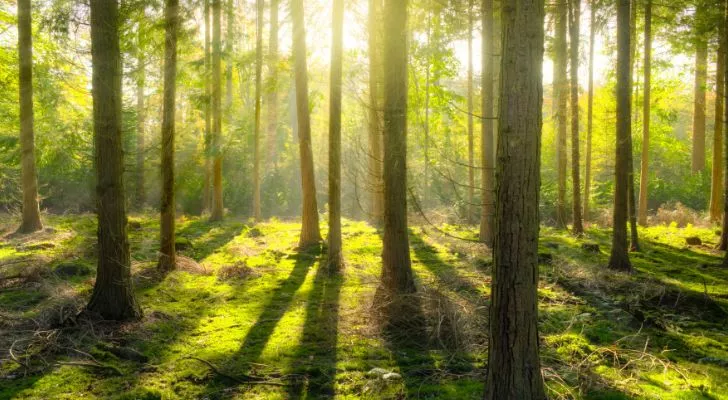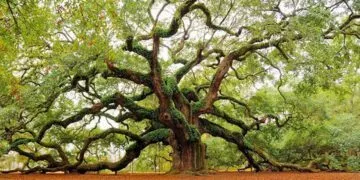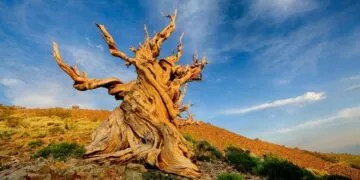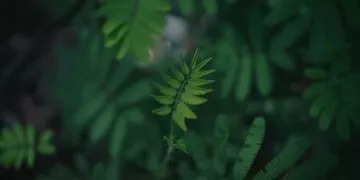Over 60,000 species of trees have been identified worldwide.
There are an estimated 3 trillion of them across the globe, which works out to about 400 or so trees for each person.
Trees have evolved in many fascinating ways, so keep reading to discover 30 terrific facts about trees!
Earth is about 4.5 billion years old, but trees didn’t exist for the first 90 percent of the planet’s history. The first mosses evolved about 470 million years ago, but no plant grew taller than three feet (1 meter) for millions more years.
It was another 85 million years (around 300 million years ago) before the first true trees emerged, transforming the atmosphere into an oxygen-rich environment where humans and other animals could live.
Forests cover around 30 percent of Earth’s total land area.
It’s estimated the Earth has about 46 percent fewer trees than it did 12,000 years ago when humans began to develop agriculture.
Over half of the forests in the world are found in just five countries: Russia, Brazil, Canada, the U.S., and China.
Countries with the least forest cover include desert countries, including Egypt and Libya; small, densely populated countries, such as Monaco; and frigid countries like Iceland.
About 58 percent of all tree species exist within the boundaries of a single country. Places with the most of these “country-endemic” species include Australia, Brazil, China, Madagascar, Papua New Guinea, and Indonesia.
Brazil has the most species of trees, with over 8,700. About half of them are found only in Brazil.
Although tropical rainforests cover only about three percent of Earth’s surface area, they are home to around half the planet’s animal species.
The Amazon rainforest contributes an estimated 20 percent of Earth’s oxygen. However, phytoplankton in the oceans contribute a whopping 70 percent.
About 18 percent of the world’s forests are located within the boundaries of protected areas, including national parks, game reserves, and conservation areas. The largest share is found in Africa, with 31 percent. Europe has the lowest at 5 percent.
Any mature tree during its dormant period is 99 percent dead. The only living parts of a tree are the leaves, buds, vascular tissues (phloem and xylem), and root tips. The rest of the tree’s mass provides structural support.
Trees get about 90 percent of their nutrition from the Sun and the atmosphere and only 10 percent from the soil.
More than half of a typical tree’s roots grow within six inches (15 centimeters) of the surface, and most of the rest go only about 18 inches (45 cm) deep. Few species of trees have true tap roots.
The deepest tree roots ever found belong to a wild fig whose roots were found dangling in a wet cave in South Africa, 400 feet (122 m) below the surface.
Pine trees are the most common species in the world, found on all continents except Antarctica.
The rarest tree is the Pennantia baylisiana, called the Three Kings kaikōmako, which lives only on an island off New Zealand. When goats were introduced to the island, they destroyed the trees until only one was left. Scientists are working to save the tree by rooting cuttings and germinating seeds.
The tropical manchineel tree is the world’s most toxic tree, with all parts of it being deadly, including the bark, leaves, fruit, and sap. Even the smoke from burning the wood and rain dripping off the leaves can sicken or kill a human.
The dwarf willow is the world’s smallest tree, reaching a height of 2.5 inches (6.4 cm). It grows in the harsh tundra.
The tallest tree is a coastal redwood in California, standing 380 feet (116 m) tall. That’s taller than the Statue of Liberty at 305 feet (93 m). It’s around 2,000 years old.
The oldest tree in the world is a Great Basin bristlecone pine in California. It’s 5,068 years old and sits amid a grove of other ancient bristlecones.
Bristlecone pines may be the oldest individual trees, but groups of cloned trees are much older. The oldest is an aspen grove in Utah. It covers over 100 acres and consists of about 47,000 genetically identical individual trees linked by a single root system estimated to be about 80,000 years old. It’s the world’s largest single organism by mass.
The thickest tree, called “the tree of Tule,” is located in the town of Santa María del Tule in Mexico. This cypress has a circumference of 137.8 feet (42 m) and takes 105 men standing shoulder-to-shoulder to surround it. Only a few sequoias come close to its girth.
The blackest wood is ebony, which is dense enough to sink in water and can be polished to a mirror-like shine.
The Osage orange tree or hedge apple, native to the southern U.S., generates the most heat when burned.
Apollo astronaut Stuart Roosa took several hundred tree seeds with him to the Moon in 1971. Upon return, they were germinated and planted to see if they had been affected in any way. They grew entirely normally on college campuses all over the U.S.
Palm trees are not trees but are actually massive woody herbs. Bamboo is also not a tree but the largest member of the grass family.
If you carve your initials in a tree and come back in ten or twenty years, the initials will be at the identical height as they first were. (Please don’t do this.)
A large oak tree can drop 10,000 acorns in a single year, feeding over 100 species of animals.
In Baltimore, a 10 percent increase in tree cover on city streets corresponded to a 12 percent decrease in crime.

Trees are wonderful in so many ways: The addition of just one large tree in the middle of an open pasture increases bird biodiversity from nearly zero to as high as 80.
The cooling shade offered by a single mature tree is equal in chilling power to two central air conditioners.
Hospital patients recover eight percent faster if they can see trees from their hospital window.
Remember these facts about trees, and show your appreciation by planting one any chance you get.


















